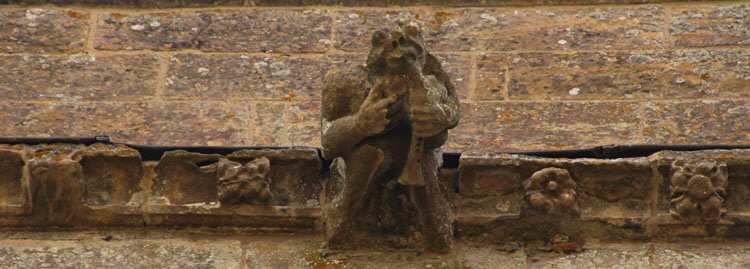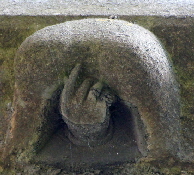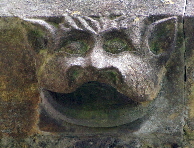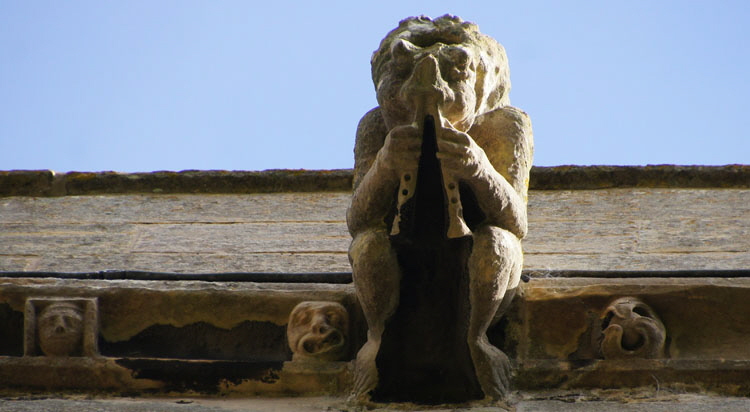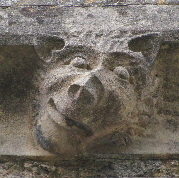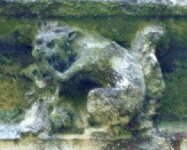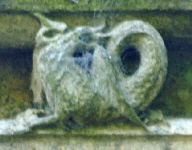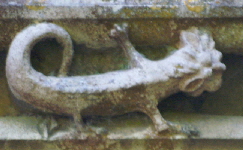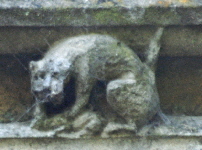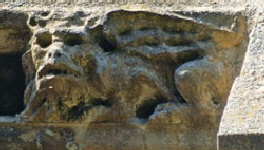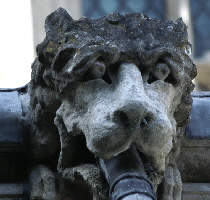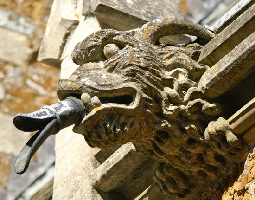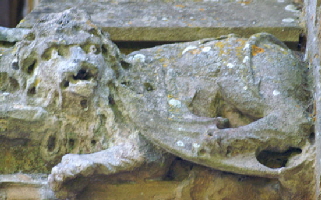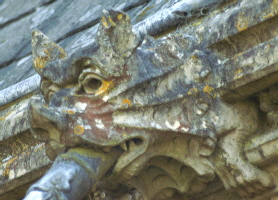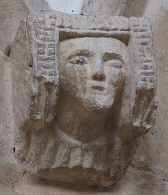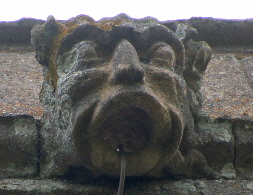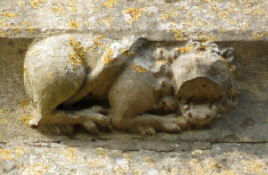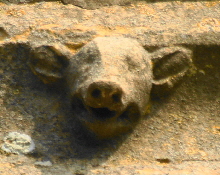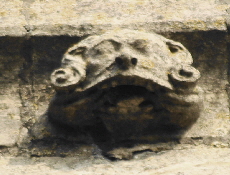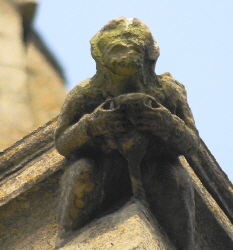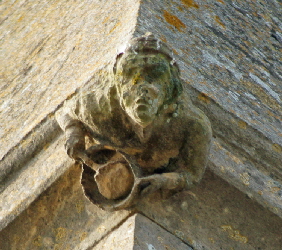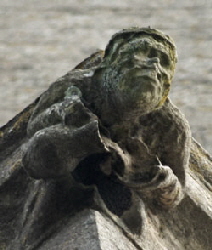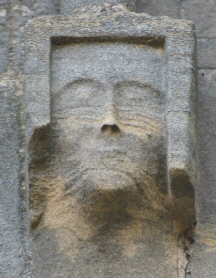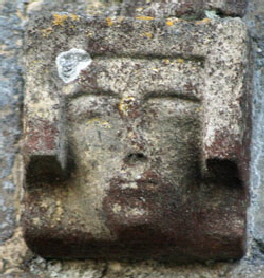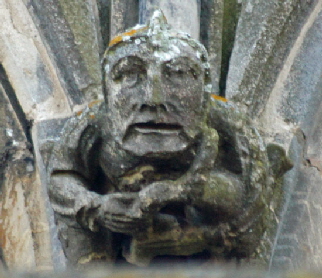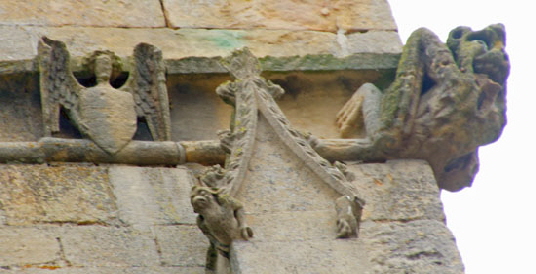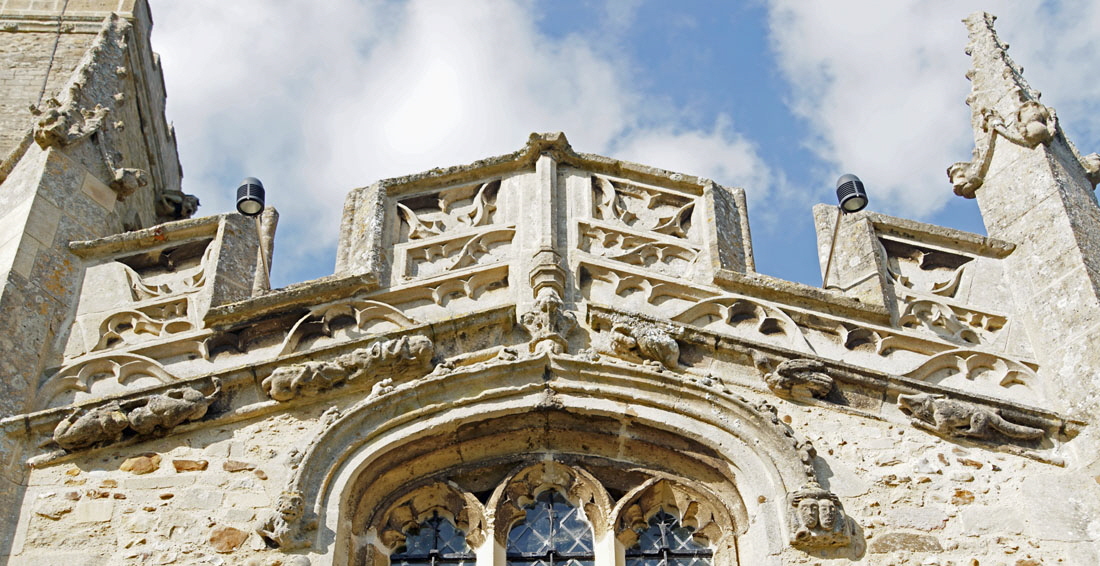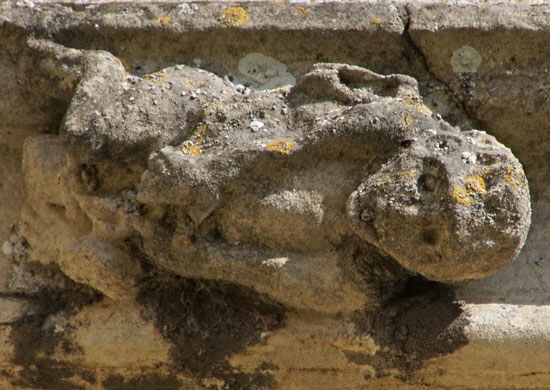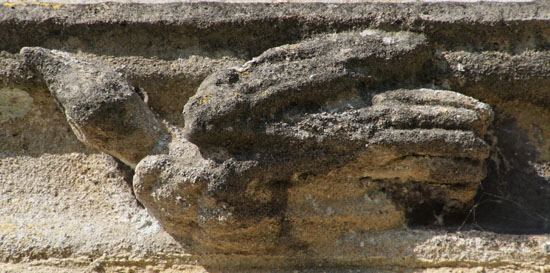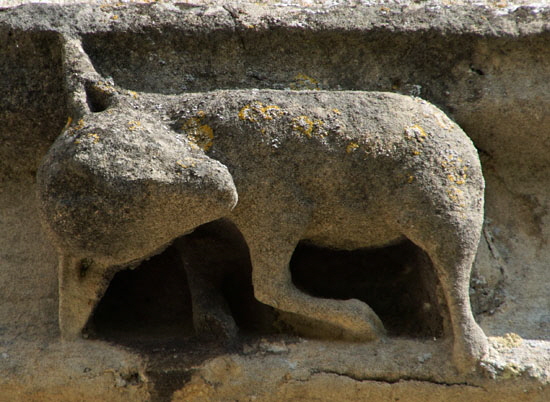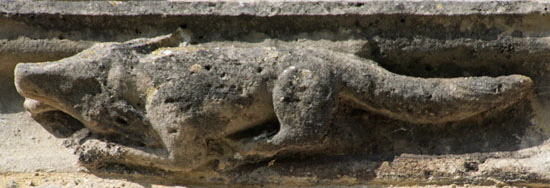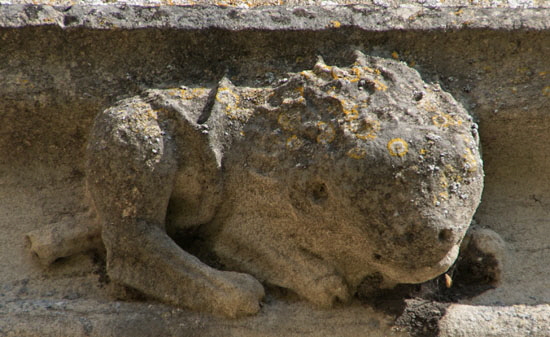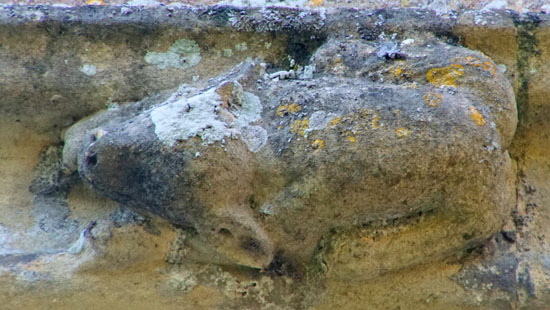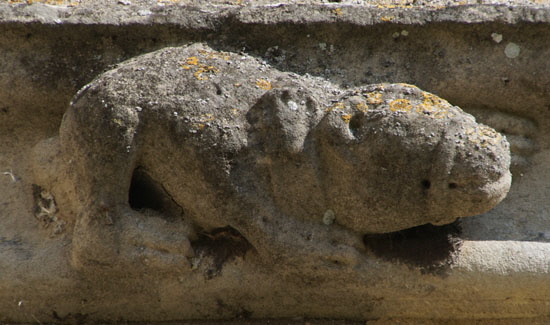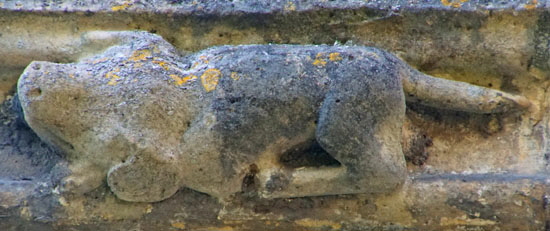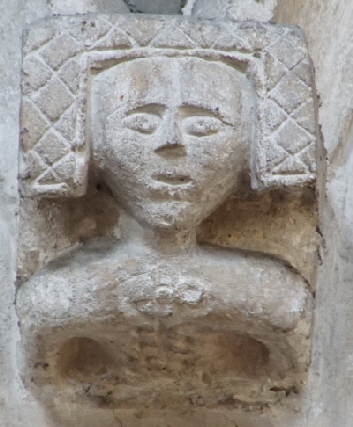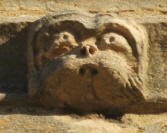|
|
 |
|
|
 |
 |
 |
|
If you have ploughed through all of this account from beginning to end - and bravo if you have - it is time for me to remind you (and myself!) that the fashion for carving sub-parapet cornice friezes is an East Midlands speciality. the South East Midland even, Although I have focused on the Mooning Men Group of masons and on John Oakham they were not responsible for all such carvings in the area. Whether this was a long-standing local fashion adopted by the MMG or whether the MMG’s work influenced other masons in the area we cannot know. Cornice friezes also do exist outside this area. It is the comparative prevalence of them in the East Midlands that is striking.
The friezes listed below could even by MMG members who ventured further afield or who went to work with other contractors. Again, we can never know. Some are reminiscent of the MMG but none - save one - has the iconic mooning man or flea carving. That exception is Staunton-in-the-Vale which has a mooner that has a close resemblance to the MMG trademark.
|
 |
 |
|
Staunton’s frieze has been extensively re-carved; indeed the church was extensively re-built by the Victorians to the extent that it is hard to make sense of it architecturally. The tower has a badly-weathered cornice frieze that is clearly mediaeval. Intriguingly, amongst the battered and undistinguished fleurons and heads with drilled eyes is a very clear goffered caul headdress, placing this decoration, at least, within the late fourteenth/early fifteenth century time frame of the MMG and John Oakham. The friezes on the north and south sides of the church are of higher quality. mainly comprising grotesque heads. Amongst them is a mooner who, not to put too fine a point upon it, seems to have a finger exploring his own orifice! here appears to have been some quite interesting tower gargoyles that have badly decayed. Definitely of interest is a set of delightful and quite splendid pinnacle carvings.
It does not seem to me to be at all impossible that John Oakham. at least, was involved here but there is no strong evidence that he was either.
|
 |
 |
|
Top and Above: The battered Staunton tower frieze is a typical mix of uninspiring fleurons and grotesques. The goffered caul headdress (lower picture, extreme left) is an intriguing departure into the human world and the headdress puts the frieze firmly into the time period of John Oakham and the MMG. Quite what, if any, connection there is with them we cannot know. The mooning man on one of the wall friezes (top right) is almost but not quite of the MMG pattern. But this church is well outside the MMG stamping grounds. It is not, however, well outside John Oakham’s extra-MMG orbit. Was he here? Note the musician gargoyles. Welbourn also has musician gargoyles where John probably sculpted. We can make connections readily. The problem is that we can’t always know whether they are mere coincidence. Put that off-beat mooner with a goffered caul headdress, however, and you might reasonably assume some connection with the MMG - a wandering mason, a contractor-mason with a different “crew”? But you can’t know what it is. The right hand series of pictures is taken from the wall friezes and the carvings are, to the best of my judgement, mediaeval rather than Victorian replacements (of which there are many). The are reminiscent of MMG carvings but not attributable to any of the “named” individuals.
|
 |
 |
|
Little Dalby’s frieze is splendid. The church is only four miles from Whissendine, not much further from Langham and Cold Overton and is, therefore, on the eastern fringes of MMG territory. In geography and the style of its frieze then it is right there begging to be identified as part of the MMG nexus. Sadly, however, there is not a single trademark carving to point us in that direction. The Victorian remodelling here was comprehensive but the friezes over the Perpendicular style clerestory have miraculously been kept. The designs are of fleurons and a real menagerie of grotesque animals. One can’t help feeling that there are familial links with the MMG but we can’t identify them. The flush gargoyles on the lower levels of the church do have a distinctly John Oakham-ish look to them, reminiscent of those at Harlaxton and Denton. Do I think that he was here? Yes, I do but I can offer only subjectivity and no evidence beyond that intriguing proximity to MMG churches. Was this John working outside the MMG as we know he did for a long time?
|
 |
 |
|
Three of Little Dalby’s flush gargoyles. The one of the left (a dog?) is reminiscent of John Oakham’s. On the right a very nice lion carving with dragon wings tucked away.
|
 |
 |
|
We have talked so far about two churches at which there was an outside chance that John Oakham was involved. Greetham shows no sign of anyof the MMG masons. Yet it has an extensive frieze of rather monotonous carvings - and large numbers of goffered caul headdresses.
|
 |
|
|
 |
 |
 |
|
Langtoft has clerestory friezes of total mediocrity. They lack trademarks and they it is a monotonous series of mean little fleurons and heads. It is always wise, however, to remember that frieze carving was a “finishing off” activity and mediocrity does not necessarily rule out the presence of the MMG or of one or more talented sculptors: it just means that a mason of no great talent was appointed to the task. Two things give pause for thought before we dismiss the presence of the MMG altogether. Inside the church is a very prominent spandrel carving of a woman with a goffered caul headdress. If, as seems likely, this was carved when the arcades were altered to accommodate the clerestories and probably a widening of the aisles it suggests that the friezes were carved within the time frame of the existence of the MMG. What is more, this figure has black lead eyes. The second bit of food for thought is a flush gargoyle that may be attributable to John Oakham.
|
 |
 |
|
So far in this chapter we have seen only one frieze - Little Dalby’s - that is half-decent. Lenton’s is another that is. Its only frieze adorns its Decorated style tower with broach spire and that style tells us that it is too early for the MMG. And indeed it is nothing like any of the friezes seen elsewhere on these pages. In many ways, the overall “feel” of the frieze is similar to some of the MMG’s work. Its piece de resistance, however, is its corner carvings which show exquisite delicacy of carving.
|
 |
 |
|
Individual carvings include (left) a damaged lion, (second left) a merman, (second right) a happy little piggy and (far right) a posh-looking man.
|
 |
 |
|
Three corner carvings. Note the delicacy of (centre) the saucepan and spoon (?), and (right) the jug.
|
 |
 |
|
Stamford is an exquisite town that has a long history of prosperity, latterly due to its strategic distance from London on the stagecoach route of the Old Great North Road. In mediaeval times, as in so many places, wool was the money-spinner and this money enabled continual modification and expansion of the many town churches. Today there are few finer sights in England than of Stamford’s six surviving church towers standing proudly above the stone town like a squad of watchful soldiers daring anybody to mess with the town. Despite the depredations of well-intentioned benefactor merchants with more money than sense, Stamford retains two churches of architectural note. One is St Mary’s - the one that appears on all of the postcards - with its awe-inspiring Early English tower and broach spire, amongst the finest in England. The other is All Saints which retains courses of early English blind arcading around its aisles and perhaps has the finest mediaeval architecture of all the Stamford churches. Its west tower is a riot of sculptural art and with it a sub-parapet cornice frieze. It is not the most interesting - and it is worth emphasising that tower friezes rarely are - but it is of a quality that dares to look the town in the eye. There is no evidence whatsoever of MMG involvement,
|
 |
|
|
 |
 |
|
|
 |
 |
|
|
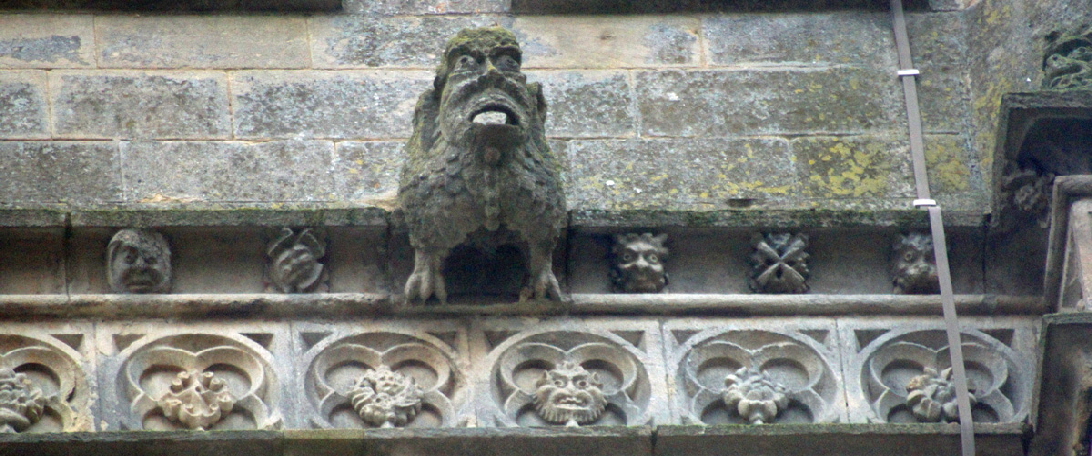 |
 |
 |
|
This is a superb church in every way. The internal sculpture, both monumental and secular is outstanding. So are the external gargoyles and label stops. The tower frieze, however, is quite ordinary. It cannot be attributed to any member of the MMG. Bottesford is, however, close to Muston, Harlaxton and Denton and only four miles south of Staunton-in-the-Vale. John Oakham was undoubtedly involved in the first three - my so-called “Harlaxton Triangle”. Is John the common denominator in this clump of sculpted churches in the Grantham area? Goffered caul headdresses are much in evidence, especially on label stops but there’s more than one on the frieze as well. This is not MMG country: the lack of mooners (other than at Staunton) attest to that. But it is not difficult to make a case for John Oakham’s having had a big part to play as a sculptor at all of these churches, probably as part of another peripatetic lodge of masons under one or more contractor-masons.
It must be said, however, that Bottesford has one of the finest collections of mediaeval sculptural art in the country, never mind the East Midlands. Whether John Oakham did or did not carve here is almost an irrelevance within that context. Nevertheless we know from the goffered caul headdresses that some of this sculpture was at the “right” time. We know John worked in this area. It seems to me that there is a strong probability that he found work here. I think it highly unlikely that he came here just to carve that mediocre tower frieze. What else did he carve here?
|
 |
|
|
 |
 |
|
|
 |
|
|
 |
 |
|
The tower frieze of Bottesford Church with plenty of goffered caul headdresses to see.
|
|
 |
 |
|
Left and Second Left: label stop heads with goffered caul headdresses. Second Right: Some of the best carvings are found on the spandrels of the clerestory windows - a most unusual location. This one shows a man and a rather odd pig-like figure embracing. Far Right: A bagpiper.
|
 |
 |
 |
 |
 |
 |
 |
 |
 |
 |
 |
 |
 |
 |
 |
 |
 |
 |
 |
 |
 |
 |
 |
 |
 |
 |
 |
 |
 |
 |
 |
 |
 |
 |
 |
 |
 |
|
 |
|
|
|
 |
|
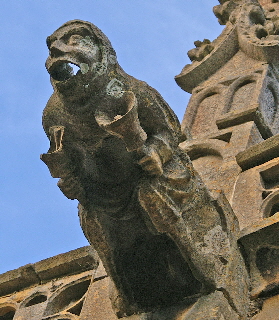 |
|
|
|
|
|
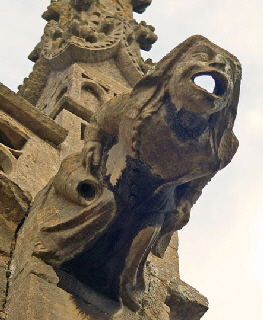 |
|
|
|
|
|
|
|
|
|
Left and Second Left: A king and queen - the king holding a sword in his right hand. This is King Henry IV. How do I know? Firstly, he is the only king of the era that had a beard - surprising as this may seem. Secondly, that distinctive forked beard is exactly how he is depicted in a miniature of 1402. Thirdly, his reign of 1399-1413 is exactly in line with the fashion of the goffered caul headdress that appears so prolifically. This being the case, the queen is his second wife Joan of Navarre who he married in 1403. Henry’s first wife, Mary de Bohun (whom he love dearly according to contemporary accounts) died in 1394 before he became king. Second Right and Far Right: Two spectacular gargoyles. On the left a bell-ringer - perhaps a town crier of some sort? On the right and ale wife carrying bowl and jug.
|
|
|
|
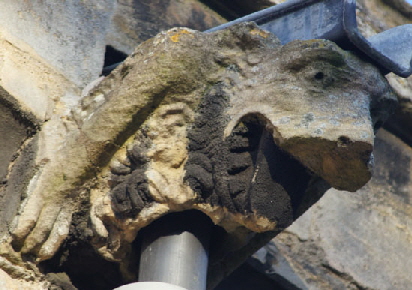 |
|
|
|
 |
|
 |
|
|
|
|
|
|
Left: A flush gargoyle, possibly a John Oakham creation. Centre: A monster carving in a clerestory spandrel. Right: This man and beast on a corner carving look quite chummy! The man carries a sword in one hand and a small shield in the other.
|
|
|
|
For my full Web Page about Bottesford Church Click HERE
|
|
|
|
Southwell Minster (Nottinghamshire)
|
|
|
|
As you would expect with a cathedral, Southwell is endowed with much beautiful sculpture, including the celebrated “Leaves of Southwell” inside the Chapter House. None of this decoration - much of it much earlier than than the period about which I have been writing - is of any interest within the MMG/John Oakham, narrative. One little section of frieze, however, is intriguing. It does have the “flavour” of an MMG/John Oakham frieze. One or two label stops on this same section of wall also have goffered caul headdresses. Was the frieze by one of the masons that worked within the MMG? Well possibly, but probably not. If the frieze is contemporary with those goffered cauls, however, we can see that frieze carving - and in this case it can only have been associated with alterations to windows and rooflines - was popular in fashion in even the noblest churches in the area.
|
|
|
 |
|
|
|
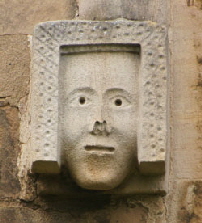 |
|
|
|
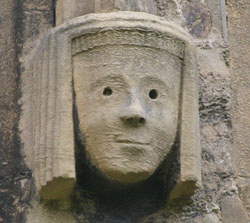 |
|
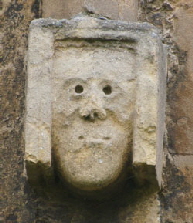 |
|
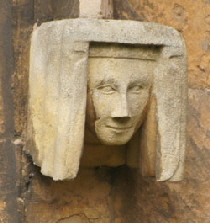 |
|
|
|
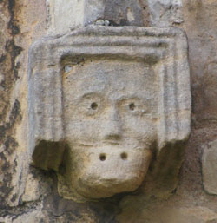 |
|
|
|
|
|
|
|
|
|
|
|
|
|
An intriguing frieze and an array of goffered caul label stops, Southwell Minster
|
|
|
|
Silk Willoughby (Lincolnshire)
|
|
 |
 |
|
Silk Willoughby is very close to Sleaford and Heckington of the “Sleaford Cluster”. There is no sign that the church’s tower frieze is anything to do with the masons who carved at the cluster churches or of any connection with John Oakham.
|
 |
|
|
 |
 |
 |
|
As we have seen, the fashion for sculpted friezes in the East Midlands stretched as far as the Boston area near The Wash. Swineshead, Boston and Leverton all saw the presence of John Oakham. These three were not alone in the area, however. Old Leake is one of two churches - see also Kirton below - that also have extensive friezes although it is not possible to identify John positively. There are little clues and it is far from implausible that John was the instigator of all the frieze sculpture in the area but there is no positive evidence. Decide for yourself!
Old Leake’s frieze is on its clerestory. Like most of the churches in the area it is of considerable size. Its parapets, in fact, are a strange mixture. The clerestory has decent plain parapets. The chancel and the east end of the nave are attractively balustraded, The west tower is battlemented and the aisles are - er - completely undecorated, their large expanses of lead revealed in all their naked ugliness. It’s a bit like seeing Marilyn Monroe wearing Norah Batty’s wrinkled stockings. The carvings themselves are densely packed, numerous and some are very inventive - if we could only make out what they were meant to be, since this frieze - like those at Boston - has suffered from considerable weathering.
|
 |
 |
|
Scenes from Old Leake Clerestory Frieze. There is so much that is novel here. A man is hauling on a pulley. Or is it a bollard, Old Leake being close to the sea? Men hold the rims of buckets - or maybe ale casks? Amongst the innovation there is much that it is familiar across all of the many friezes in this narrative. A grinning pig is very like one at Boston. One or two (the big oak leaf, the blemy (torso-less man) are even similar to carvings at Cottesmore and Whissendine within the MMG. The density of the carvings is conspicuous, often with two sculptures per short length of cornice. In many places the cornice seems in danger of detaching from the walls.
|
 |
 |
|
Kirton’s frieze, like Old Leake’s, adorns its attractively parapeted clerestory and its tower. Perhaps the Kirton had more money that Old Leake because its roofs are battlemented throughout. Its frieze, however, has none of the occasional ambition of Old Leake, just run-of-the-mill heads and fleurons. The clerestory sculpture, however, is quite neatly-executed and vaguely reminiscent of John Oakham/Simon Cottesmore sculpture elsewhere, including within the Mooning Men Group area. Again, that is a judgement call for the observer. The tower carving is more ambitious and so is the buttress sculpture. I think, however, it is safe to say that the sculptors here and at Old Leake were not the same. I have made much of the Mooning Men Group as a kind of mediaeval building “company” , working within a limited area with changing personnel, going from place to place raising clerestories, widening aisles, leading roofs and building parapets with cornice friezes. It is certainly far from implausible that a similar peripatetic stonemasons lodge was at work in south east Lincolnshire, based around Boston. If it existed John Oakham would probably have been part of that lodge as he was within the MMG but, not for the first time we must say that we cannot know what precise role he played.
|
 |
 |
|
What constitutes “local” you might well ask? Buckden is close to Huntingdon and St Neots in Cambridgeshire, seemingly a long way south of the MMG “action”. But John Oakham was at Oakham and Boston which are nearly fifty miles apart! The frieze over the south porch at Buckden is startlingly in keeping with the general look and feel of many of the friezes further north and it is a very fine example. What is more, glory be, a spandrel carving inside has a head with a goffered caul headdress, putting it firmly within in the time frame of this narrative. Interestingly, the Church Guide acknowledges this as an anachronism on the north aisle arcade that they date to much later in the fifteenth century; they suggest the carvings were re-used.
The Church Guide talks of alterations to the porch in 1435 and so this seems then the best estimate of this frieze too - some three decades perhaps after the MMG/John Oakham friezes. The parvise room, however (the second storey) is placed at 1485. Now that does seem very late for this frieze. Was it too reused from an earlier phase? A tradition does not die out overnight. Or is there a different story to be told here? Either way, we can see at Buckden a porch very much in the spirit of those we have seen further north and east. Nothing, however, points to its having been executed by one of the masons previously mentioned. Interestingly, there is another goffered caul headdress on the apology for a frieze in the cornice of the top stage of the west tower. Now that, I think, was executed in the early fifteenth century!
|
 |
 |
|
Every carving on the the frieze over Buckden’s porch is significant: there are no fillers of fleurons and grotesque heads here. There are many hunting scenes, reflecting no doubt, the bishops’ delight in the more lordly mediaeval pursuits. Note particularly, a hound being savaged by a wild boar. Top left is a surely an obscene carving. It could be a man or it could be a monkey, but it is most certainly not an “owl” as suggested in the Church Guide. Above Right: A goffered caul headdress on a north aisle spandrel carving.
|
|
